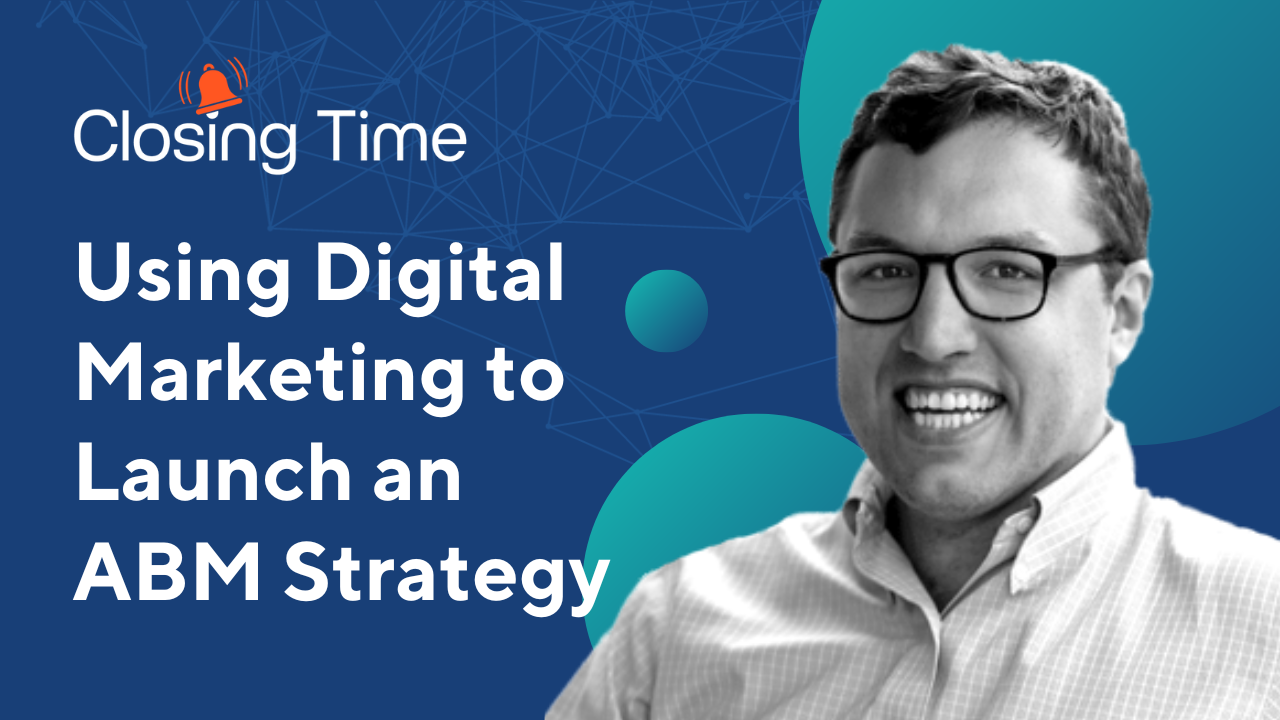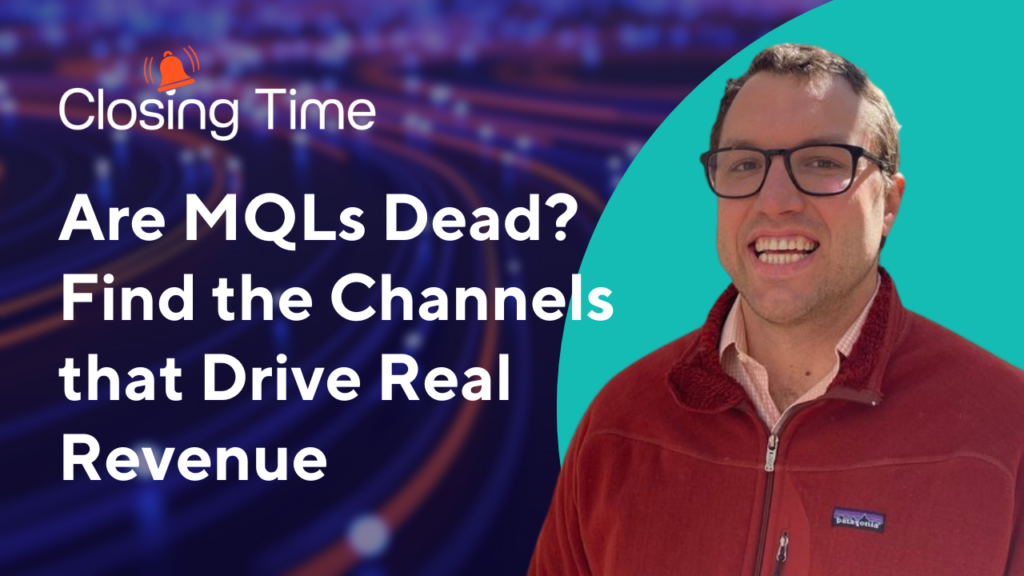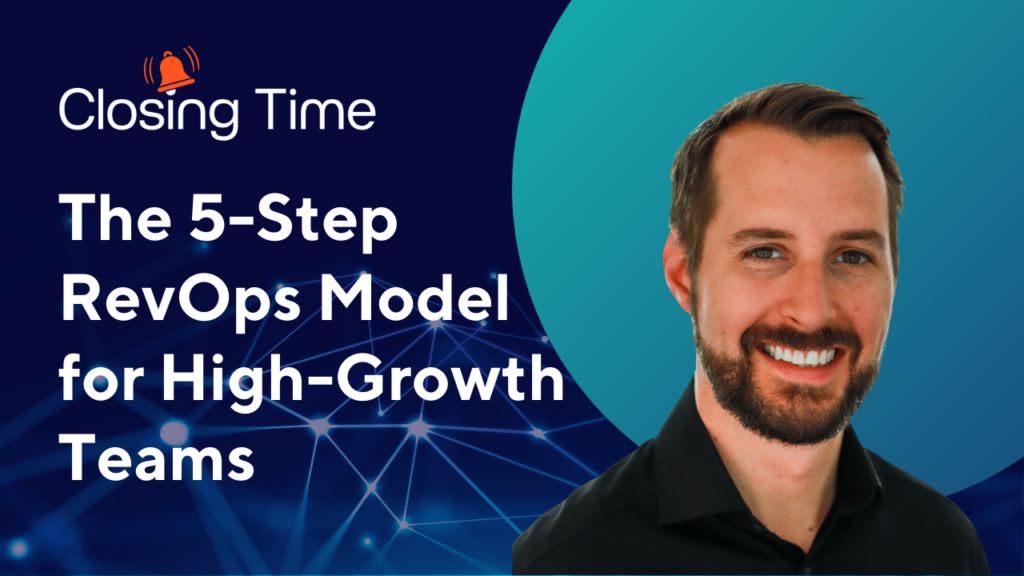Shifting to an account based marketing structure can be ideal for the right companies. We’re going to talk all about ABM in this episode of Closing Time. Hey everyone, My name is Chip House. I’m the CMO at Insightly. Today, I’m super excited to be joined by. John Short. John is the CEO of Compound. Growth Marketing. There are demand gen firm and John has tons of experience in marketing and I’m super excited to talk to him. Welcome, John. Thanks, Chip.. It’s always a pleasure talking to you. I always learn something every time I talk to you. Yeah, well, same,. I learn something as well. And, you know, ABM, this term was popularized, obviously by Terminus and others, Demandbase. And then 6sense more recently. And a lot of companies are moving in this direction. But let’s first define it for everybody who’s maybe not familiar with what ABM is. My definition of ABM starts with when companies are focused on identifying a segment or a finite number of accounts that they want to go after, rather than what we see with the inbound or PLG motion where you’re trying to drive in a ton of leads through the top of the funnel, qualify those leads and then pass them to your sales team. It’s kind of flipping that approach, which I think Terminus has popularized. Yeah. Flip flipping the funnel. Yeah, flipping the funnel. And what I look at this,. I think there’s a great article out there by Christoph Janz, who is a European investor, and he wrote an article called The Five Ways to Build a $100 million Company. It looks at the average deal size of a company and what the go to market motion typically is. So when you’re trying to sell a product for a dollar, usually having an outbound sales team, building field sales reps, doing on site visits, is not going to work for like a WhatsApp in the world, right? You cannot afford to, you know, come meet with John in order to get me to buy a $1 a year app from you. Once you get to a 50 to $100000 ACV, that’s when you start to see this account base motion really start to take shape where you are able to focus on a finite number of companies and still build the type of scale and build the type of company that you’re looking to ultimately take public, which I think is the goal for a lot of SaaS companies. So it’s a great article. You can go to Google, do a search on it, and and there’s some really valuable information in there. So kind of at the kernel of that with account based marketing is the fact that you’re having sales and marketing more aligned because they’re agreeing on the same set of accounts that they’re going to go target, right, number one. Yeah. And so you’ve kind of hinted at it, but this allows you to pick the accounts versus having them pick you, which is basically a typical inbound motion. And that provides some advantages. But, you know, how does a marketing team first identify the set of accounts with sales? What should I be looking at? Yeah, So when we work with companies or when I talk with CMOs or CEOs who are running an account based motion, what I often see is they’ve come to us and they’ve already decided internally we want to run some account based marketing and they go out and buy that display tools and they aren’t focused on identifying the ICP. And I think you need to flip that a little bit to where there’s three steps to account based marketing. First is sales and marketing integration. It’s aligning with your sales team on who your ideal customer profile is. What makes that customer unique to you or what allows you to sell into that customer profile really well. What are the needs they have? What are the inflection points they go through in order to need a product like yours? And so that really is critical. And so a lot of times. I recommend like an SLA with your sales team of kind of writing some of these things down because I think it brings the two teams together. When you have this mutual agreement of the types of companies that you’re going after. Yeah, so that was step one. So aligning with your sales team on the ICP, right? Yeah. And also part of step one,. I think it’s really important to have your CRM in a really good place. Again, I see a ton of companies that skip a ton of steps and they go immediately to how can we shower these accounts that we’re going after with display ads. And there’s a lot of low hanging fruit before that. The promise of account based marketing to me and the technology innovation that I thought we were going to see, tighter integration between the sales and marketing team. So you’re setting your sales team up for better conversations to have with the accounts that they were going after. So I think one piece of that is giving them information and intelligence on company size, who the right people are to be targeting at that company, who the right people are to be having conversations, but also setting your sales team up to have really good initial conversations by, you know, the the example I always provide is providing intelligence of like, you know, news clippings or press releases from that company. So you can say, hey, I saw you just signed X, Y, Z, new customer, congratulations on that, or you just brought on a new CRO or, you know, all these different things that can help set your sales team up for better initial conversations with the team. And then, so the CRM is a critical piece to account based marketing and making sure you’re getting all the data in there. That is the front end of marketing to the sales team. That’s where we can put all our data to make sure the sales team has what they need. So the first is like agree on ICP, make sure you have the data ready and in your CRM. One more note on that sales and marketing integration piece is, I think marketing brings the skillset of analysis to help look at the characteristics of your ICP and what industry they’re in, what job titles you’ve been selling into, what deals have moved quickest through the funnel, what drive the longest lifetime value of that customer. Marketing can really help you with segmentation from a data perspective and also a qualitative perspective of understanding who your ICP is, who you should be going after. Sales is providing the feedback. I oftentimes think of sales as like the eyes and the ears of a lot of SaaS organizations, where they’re in the field, they’re talking to the customers and they are getting intelligence and providing that feedback and to the marketing team to say, Hey,. I just spoke with this company. They need an end to end. You know, profile of what the customer looks like across their marketing automation system, their CRM and and like customer onboarding. And for if you’re a CRM like Insightly, like, okay, perfect. Like when, when these customers are needing each of these different things, that’s the ideal customer profile for us. So they have, you know, they’re looking for a tight integration for between all the different customer success, sales, and marketing teams. And so that helps feed the insights to build out the ICP. So the first is like agree on ICP, make sure you have the data ready and in your CRM. And then kind of second, we’re moving on to engagement. Engagement is looking at low hanging fruit rather than skipping to trying to build out display program, shower people with display ads, you know, starting to test the waters by looking to get introductions into the account, starting to email them directly to try to establish conversations. I also think that co-marketing can be incredibly valuable in account based marketing where if you have an ICP and there’s another software vendor in your space or another vendor in your space, maybe it’s hardware, maybe it’s something else. But they have a lot of the customers that you’re looking to get. co-marketing can be a great opportunity to get in front of that audience and you can go see it. It can be something as easy as looking at the logos on that website to understand if there’s some synergies between your two companies. But I love that and I think that’s underused in account based marketing. I think people skip over some of this low hanging fruit and that’s where the engagement is really important. And also, again, kind of going to that sales and marketing integration. I think in the engagement step, we want to make sure that there’s a good motion of providing your sales team with the information they need in order to have those really good, high quality initial sales calls. So we’ve talked a little bit about funnels and I like John Jansen’s, the know, like, trust, try, buy, repeat, refer. That’s kind of my favorite funnel because I think it really hones in on what has to happen, you know in an ABM relationship, right. That the marketing team is responsible for, still for ABM, is creating some of that awareness. So when the salesperson calls or emails, you’re going to increase the chance that something gets opened, something gets clicked on, a call happens with the sales rep. And so it makes me want to drill into it a little bit with you, John. On the engagement side, as I’m thinking through, you know, kind of bringing a potential account, you know, especially the key personas inside of my target set of accounts along for the ride. You know, what should my paid strategy be? You know, what should buy organic strategy be and how do I know if I’m being successful? So one, your sales team is a little bit more on offense here. You have more campaigns that are going to outbound to reach out to these customers. You’re waiting less for them to come in and raise their hands. But I still think that can be a really valuable indicator of marketing campaigns that are working. There are also a lot of really good tools we’ve used, like Clearbit previously to identify when our target accounts are visiting our site and what they’re doing when they’re on our site. And so again,. I think that can be a powerful indication that you are doing the right things to attract the right customers, to view the pages on your site. And when we last spoke, I talked about using Google Analytics to look at converters versus non converters. I think you can do a similar thing with accounts to understand how often they’re interacting with the content. You send them via email, how they’re interacting with your website and using that to kind of bubble up the leads that are most active or the accounts that are most active that you want to make sure your sales team is engaging with. So I think that is one way to to pay attention to it. And then the other is looking at the engagement you drive even if your reps reach out outbound and eventually get a conversation because of that, it doesn’t mean your marketing didn’t work. It’s still important to have those metrics to understand, you know, if your ads got in front of that account, if that account had previously visited the website, I guarantee you somebody who’s visited your website is more likely to respond to a sales reps email than somebody who has never visited your site before. So you need to pay attention to all the touchpoints across the journey. Yeah, that’s great advice. And if you’re doing this right, sales is not making cold calls because marketing is doing the work ahead of time to create that awareness to kind of start the journey. That’s that’s part of the point in this alignment on ABM. So what are your final thoughts on ABM and how it relates to sort of the the Matrix that we talked about before, which is intent on one axis and ICP on the other? It’s still,. Hey, let’s find the right people and let’s find the right people who are potentially in market. Yeah, find the right people, find the right people who are starting to have the pain or are coming into the market for you and look to drive the demand to get those people to raise your hand. I think that should be the ultimate goal of marketers in an account based marketing motion. Cool. Any final thoughts on ABM, John? One of the things we found to be most successful is really making sure to define your market really tight. I think if you’re targeting, if you have a target of countless to 5000 accounts and you’re and you’re not like a gigantic company like Workday, you probably are targeting way too many accounts. So really focus on how you can segment your ICP and find the sweet spot of customers that are truly going to be interested and truly going to have a high conversion velocity through your funnel or flip funnel, whatever you want to call it. Cool. Well, John, thanks so much. Love the discussion today and hopefully we’ll have you back. Thank you for having me on. And thanks to all of you for joining us on this episode of Closing Time. And we’ll see you next time.




